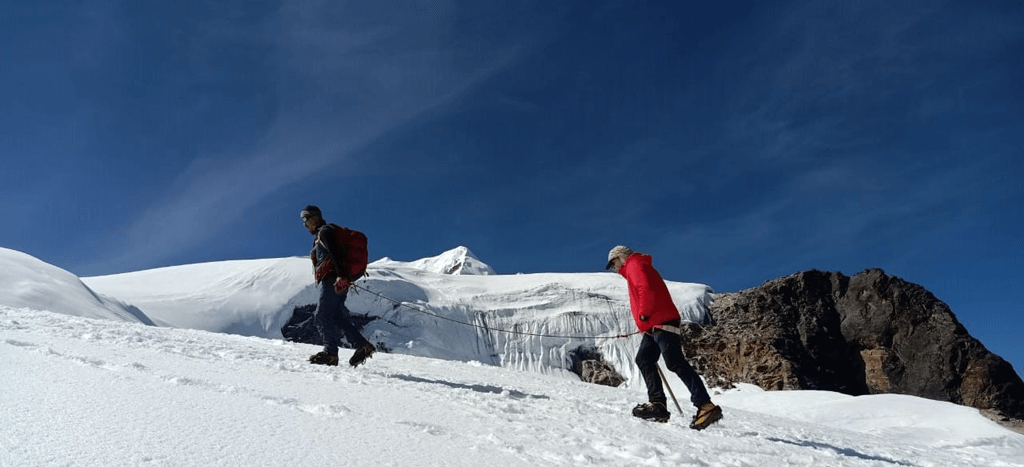17th June, 2025

Mar 01, 2024
Mera Peak Climbing In April
- Why Mera Peak Climbing In April
- How Difficult To Climb Mera Peak In April
- I Never Climbed a Mountain. Can I Climb Mera Peak?
- Mera Peak Cost
- Highlights of Mera Climbing in April
- Can I Climb Mera Peak Without a Guide
- Can I Hire Equipment from Khare
- Solo Climb to Mera Peak
- What Should I Pack for Mera Peak Climbing In April
- Altitude Sickness and Acclimatization
- Mera Peak Successful Tips
- Conclusion
- Mera Peak Climbing Packages
Climbing Mera Peak in April presents an enticing adventure set amidst Nepal's Himalayan splendor, characterized by favorable weather conditions and breathtaking landscapes. April marks the beginning of the spring season in the Everest region, offering climbers a perfect blend of clear skies, mild temperatures, and blooming rhododendrons along the trekking trails.
The journey typically starts with a scenic flight from Kathmandu to Lukla, followed by a trek through picturesque Sherpa villages like Namche Bazaar and Pangkongma. As climbers ascend towards Mera Peak Base Camp, they traverse through lush forests adorned with vibrant rhododendrons, adding a colorful backdrop to the trekking experience.

MERA PEAK CLIMBING
This is an excellent opportunity to climb Nepal’s highest peak without having to obtain a permit (6,476m/21,190ft). From the summit, you will have stunning views of several 8000m plus peaks, such as E...
April provides stable weather with minimal precipitation, making it an optimal time for climbing Mera Peak. Clear skies ensure excellent visibility of the surrounding Himalayan giants such as Everest, Lhotse, and Makalu throughout the journey. The mild daytime temperatures, ranging from 5°C to 15°C (41°F to 59°F) at lower elevations, create comfortable trekking conditions, while colder temperatures higher up necessitate proper layering and gear.
Summit day typically begins before dawn, allowing climbers to ascend Mera Peak's challenging slopes and glacier crossings under starlit skies. The reward at the summit, standing at 6,476 meters (21,247 feet), is a breathtaking 360-degree view of the Himalayan panorama bathed in the morning light.
Descending from the summit, climbers reflect on their achievement amidst the tranquility of the Himalayan wilderness, encountering local Sherpa culture and hospitality along the way. April's climb of Mera Peak encapsulates the essence of Himalayan trekking: a harmonious blend of natural beauty, cultural exploration, and personal triumph in one of the world's most spectacular mountain ranges.
Why Mera Peak Climbing In April
April stands out as an ideal month for climbing Mera Peak, offering a perfect combination of favorable weather, scenic beauty, and cultural experiences:
- Weather Conditions: April marks the beginning of the spring season in the Everest region, characterized by clear skies and mild temperatures. Daytime temperatures range from 5°C to 15°C (41°F to 59°F) at lower elevations, providing comfortable trekking conditions. Minimal precipitation ensures dry trails and excellent visibility of the surrounding Himalayan peaks.
- Rhododendron Blooms: The landscape along the trekking route bursts into color with blooming rhododendrons, Nepal's national flower. The vibrant hues of red, pink, and white against the backdrop of snow-capped mountains create a picturesque setting, enhancing the trekking experience.
- Cultural Exploration: April offers opportunities to immerse oneself in Sherpa culture and traditions. Trekking through Sherpa villages like Namche Bazaar and Pangkongma allows climbers to interact with locals, visit monasteries, and witness traditional festivities if timed with local festivals.
- Achievable Summit: Mera Peak, standing at 6,476 meters (21,247 feet), is considered a non-technical climb suitable for climbers with basic mountaineering skills. April's stable weather conditions and clear skies increase the chances of successfully reaching the summit, providing a memorable achievement.
Climbing Mera Peak in April combines favorable weather, stunning landscapes, cultural immersion, and a manageable summit challenge, making it a popular choice for mountaineers seeking a rewarding Himalayan adventure.

Mera Peak Climbing 20 Days
This is the highest peak in Nepal that does not require a climbing permit (6,476m/21,190ft). From the summit there are spectacular views of several 8000 meter plus peaks, such as Everest, Cho Oyu, Kan...
How Difficult To Climb Mera Peak In April
Climbing Mera Peak in April presents challenges typical of high-altitude mountain expeditions but with favorable conditions that enhance the overall experience:
- Altitude: Mera Peak's altitude of 6,476 meters (21,247 feet) poses the primary challenge. Climbers must acclimatize properly to prevent altitude sickness, which can occur due to decreased oxygen levels at high altitudes. The ascent includes gradual climbs and rest days to allow the body to adjust.
- Physical Demands: The climb to Mera Peak involves long trekking days and steep ascents over varying terrain. Climbers should be in good physical condition, with prior trekking experience and cardiovascular fitness essential for enduring multiple days of trekking at high altitudes.
- Technical Aspects: While Mera Peak is classified as a non-technical trekking peak, climbers should be familiar with basic mountaineering equipment such as crampons, ice axes, and ropes. These tools are necessary for navigating icy slopes and crossing crevassed glaciers.
- Weather Conditions: April generally offers stable weather with clear skies and mild daytime temperatures. However, climbers should be prepared for cold temperatures, especially at higher altitudes, and monitor weather forecasts closely for potential changes.
- Logistical Challenges: Organizing permits, accommodations, and transportation from Kathmandu to Lukla requires careful planning. Engaging a reputable trekking agency or guide service ensures logistical support and enhances safety during the expedition.
Climbing Mera Peak in April requires adequate preparation, physical fitness, and respect for altitude and weather conditions. With proper planning and a guided approach, climbers can overcome these challenges and enjoy a successful ascent to Mera Peak's summit amidst Nepal's breathtaking Himalayan scenery.

Mera Peak Climbing 17 Days
This is a chance to go climbing without the necessary permits that most climbing expeditions require in Nepal. Mera Peak fits the bill perfectly and at (6,476m/21,190ft) you will have spectacular view...
I Never Climbed a Mountain. Can I Climb Mera Peak?
Yes, climbing Mera Peak is feasible for individuals with no prior mountain climbing experience but requires physical fitness, determination, and preparation:
- Non-Technical Climb: Mera Peak is categorized as a non-technical trekking peak, meaning it does not require advanced mountaineering skills such as rock climbing or ice climbing. However, climbers should be comfortable with basic mountaineering equipment like crampons, ice axes, and ropes, which are essential for navigating snowy and icy terrain.
- Physical Fitness: Climbing Mera Peak demands stamina and endurance due to multiple days of trekking at high altitudes. Prior trekking experience and a regular fitness regimen that includes cardiovascular exercises and strength training are beneficial for building physical resilience.
- Altitude Acclimatization: Proper acclimatization is crucial to prevent altitude sickness, which can affect climbers at high altitudes. The ascent to Mera Peak includes gradual climbs and rest days to allow the body to adapt to decreasing oxygen levels.
- Guided Expeditions: Joining a guided expedition led by experienced Sherpa guides enhances safety and support during the climb. Guides provide logistical assistance, route guidance, and monitor climbers' health and acclimatization progress throughout the journey.
- Training and Preparation: Undertake training hikes and practice using climbing gear under supervision to familiarize yourself with mountaineering techniques. Attend a mountaineering course if possible to gain confidence and skills before attempting Mera Peak.
While climbing Mera Peak as a novice requires dedication and preparation, it offers a rewarding introduction to Himalayan mountaineering. With guidance from experienced Sherpa guides, proper training, and respect for altitude and weather conditions, novice climbers can successfully summit Mera Peak and experience the thrill of standing atop a Himalayan peak.
Mera Peak Cost
The cost of climbing Mera Peak varies based on several factors, including the chosen route, duration of the expedition, group size, and services included. Here’s a breakdown of potential expenses climbers may encounter:
- Permits: Climbing permits are required for Mera Peak, including Sagarmatha National Park permits and Mera Peak climbing permits. These permits are obtained through trekking agencies and incur fees, which vary based on the season and regulations.
- Guided Expedition: Many climbers opt for guided expeditions led by experienced Sherpa guides. The cost of a guided expedition typically includes guide fees, accommodation, meals, transportation (flights to Lukla), and trekking permits. Guided expeditions provide logistical support, safety assurance, and local insights throughout the climb.
- Equipment Rental: Climbers may need to rent or purchase mountaineering equipment and gear such as crampons, ice axes, harnesses, helmets, and sleeping bags rated for cold temperatures. Rental costs vary depending on the quality and duration of use.
- Travel and Accommodation: Travel expenses include international flights to Kathmandu and domestic flights to Lukla, where the trek to Mera Peak begins. Accommodation in Kathmandu, as well as during the trek, ranges from basic lodges to more comfortable tea houses or camping arrangements.
- Additional Costs: Miscellaneous expenses may include travel insurance (mandatory for climbing), visa fees, gratuities for guides and porters, personal trekking gear, and incidental expenses.
The total cost of climbing Mera Peak can range from approximately USD 2,000 to USD 5,000 or more per person, depending on the level of service, duration of the expedition, and personal preferences. Choosing a reputable trekking agency or guide service ensures transparency in pricing, safety standards, and a well-organized expedition experience.
Understanding and budgeting for these costs allows climbers to plan effectively and enjoy a successful ascent of Mera Peak, experiencing the beauty and challenge of the Himalayas in a controlled and supported environment.

Mera Peak Climbing 15 Days
Mera Peak Expedition is a popular trekking route that offers a challenging climb to the summit of Mera Peak. The peak stands at an elevation of 6,476 meters (21,247 feet) and is located in the Solu Kh...
Highlights of Mera Climbing in April
Climbing Mera Peak in April offers a host of unforgettable highlights that make it a sought-after adventure in the Everest region:
- Spring Scenery: April heralds the arrival of spring in the Himalayas, transforming the landscape with blooming rhododendrons and other alpine flowers. The contrast of colorful blooms against the backdrop of snow-capped peaks creates a stunning visual spectacle along the trekking route.
- Stable Weather: April boasts stable weather conditions with clear skies and mild daytime temperatures, ideal for trekking and climbing. The visibility is exceptional, offering panoramic views of towering Himalayan giants such as Everest, Lhotse, and Makalu throughout the journey.
- Cultural Immersion: Trekking through Sherpa villages like Namche Bazaar and Pangkongma provides opportunities to immerse oneself in Sherpa culture and traditions. Encounter ancient monasteries, prayer flags fluttering in the breeze, and possibly witness local festivals, adding cultural depth to the expedition.
- Achievement of Summit: Standing atop Mera Peak's 6,476-meter (21,247-foot) summit is a pinnacle moment. The panoramic view from the summit ridge, particularly at sunrise or sunset, rewards climbers with a sense of accomplishment and breathtaking natural beauty.
- Wildlife Encounters: April offers glimpses of Himalayan wildlife such as musk deer, Himalayan tahr, and various bird species along the trekking trails. Nature enthusiasts can observe these animals in their natural habitat amidst the serene Himalayan wilderness.
Climbing Mera Peak in April encapsulates the essence of Himalayan adventure, combining scenic beauty, cultural exploration, and personal achievement in one exhilarating expedition.
Can I Climb Mera Peak Without a Guide
Climbing Mera Peak without a guide is technically possible, but it is generally recommended to hire a guide or join a guided expedition for several reasons:
- Safety: Experienced guides are trained in mountain safety, first aid, and emergency procedures. They assess weather conditions, monitor altitude sickness, and ensure climbers' safety throughout the expedition.
- Navigation: Navigating the trekking routes and glaciers towards Mera Peak can be challenging, especially in changing weather conditions or low visibility. Guides provide route guidance, reducing the risk of getting lost or encountering hazards.
- Logistics and Permits: Guides handle logistical arrangements such as obtaining trekking permits (Sagarmatha National Park and Mera Peak climbing permits), arranging accommodation, meals, and transportation (including flights to Lukla).
- Local Knowledge: Guides offer insights into Sherpa culture, traditions, and local flora and fauna, enriching the trekking experience. They facilitate cultural exchanges and ensure respectful interactions with local communities.
- Group Support: Joining a guided expedition allows climbers to connect with like-minded individuals, share experiences, and provide mutual support during the climb. Group dynamics can enhance safety, morale, and overall enjoyment.
While it's possible to climb Mera Peak independently for experienced mountaineers with appropriate skills and knowledge of the region, hiring a guide or joining a guided expedition is highly recommended for safety, logistical support, and to maximize the overall experience.

Mera Peak Summit Return By Helicopter
Mera Peak Climbing Just in 12 Days Return By Helicopter to Lukla and flight back Kathmandu.This is an excellent opportunity to climb Nepal’s highest peak without having to obtain a permit (6,476m...
Can I Hire Equipment from Khare
Khare, a small settlement on the approach to Mera Peak Base Camp, offers basic equipment rental services for climbers. Here's what climbers can typically expect when renting equipment from Khare:
- Equipment Availability: Khare provides essential mountaineering equipment such as crampons, ice axes, harnesses, helmets, and ropes. Availability may vary, so it's advisable to confirm specific gear requirements in advance.
- Quality of Equipment: Equipment quality in Khare can vary from basic to more durable and reliable options. It's recommended to inspect the gear personally or through a guide to ensure it meets safety standards and is suitable for the climb.
- Rental Fees: Rental fees for equipment in Khare are generally affordable compared to purchasing new gear. Prices may vary based on the duration of use and the type of equipment rented.
- Booking in Advance: During peak climbing seasons like April, demand for equipment rental in Khare can be high. It's advisable to book equipment in advance through a trekking agency or guide service to secure availability.
- Alternative Options: Some climbers prefer to bring their own mountaineering equipment for familiarity and reliability. If renting in Khare, ensure the equipment is properly fitted and tested before commencing the climb.
Renting equipment from Khare provides convenience and cost-effectiveness for climbers, especially those traveling light or without personal gear. Confirming equipment availability, quality, and rental terms in advance ensures a smooth and well-prepared ascent of Mera Peak.

Mera Peak Summit 10 Days
This is a chance to go climbing without the necessary permits that most climbing expeditions require in Nepal. Mera Peak fits the bill perfectly and at (6,476m/21,190ft) you will have spectacular view...
Solo Climb to Mera Peak
Solo climbing Mera Peak is feasible for experienced mountaineers with prior high-altitude trekking and mountaineering experience. Here are considerations for undertaking a solo climb:
- Skills and Experience: Solo climbers should possess advanced mountaineering skills, including navigation, glacier travel, and crevasse rescue techniques. Familiarity with using mountaineering equipment like crampons, ice axes, and ropes is essential for safe ascent and descent.
- Fitness and Endurance: Climbing Mera Peak demands excellent physical fitness and endurance due to multiple days of trekking at high altitudes. Prior trekking experience in remote and challenging terrain prepares solo climbers for the demands of the climb.
- Risk Management: Solo climbers assume full responsibility for route finding, decision-making, and risk assessment during the expedition. They must be prepared to manage unforeseen challenges, weather changes, and altitude-related issues independently.
- Logistical Preparation: Arrange necessary permits (Sagarmatha National Park and Mera Peak climbing permits) and logistical details such as accommodation, meals, and transportation independently. Comprehensive planning and preparation are crucial for a successful solo climb.
- Emergency Preparedness: Solo climbers should carry a satellite phone or communication device for emergencies, along with a first aid kit and sufficient supplies. Familiarize yourself with emergency procedures and evacuation options in case of injury or illness.
While solo climbing offers autonomy and personal challenge, it also involves greater risk and responsibility. Consider joining a guided expedition or partnering with experienced climbers for added safety and support, particularly in unfamiliar or challenging terrain like Mera Peak.

Mera Peak Expedition 11 Days
Mera Peak is one of the most popular trekking peaks in Nepal, standing tall at 6,476 meters above sea level. The peak is located in the Khumbu region of Nepal and offers stunning views of some of the...
What Should I Pack for Mera Peak Climbing In April
Packing for Mera Peak climbing in April requires careful consideration of essential gear and clothing to ensure comfort, safety, and success during the expedition:
- Clothing Layers: Pack lightweight, moisture-wicking base layers for trekking, including thermal tops and bottoms. Insulating layers like fleece or down jackets provide warmth during chilly mornings and evenings. A windproof and waterproof outer shell is crucial to protect against unpredictable weather.
- Trekking Pants: Choose quick-drying trekking pants that offer flexibility and comfort for long hours of walking. Consider zip-off pants for versatility in changing temperatures and terrain.
- Footwear: Invest in sturdy trekking boots with ankle support and a waterproof membrane to navigate rocky trails and snowy terrain. Break in your boots before the climb to prevent blisters and discomfort.
- Headgear: Pack a warm beanie or hat that covers your ears, a sun hat or cap for sun protection, and sunglasses with UV protection to shield your eyes from glare and snow reflection.
- Gloves: Bring insulated gloves for warmth and dexterity, as well as waterproof outer gloves or mittens for protection against cold and snow during the summit push.
- Mountaineering Equipment: Rent or bring essential mountaineering gear such as crampons, ice axe, harness, helmet, and ropes. Ensure these items are in good condition and familiarize yourself with their use before the climb.
- Sleeping Gear: Carry a sleeping bag rated for sub-zero temperatures and a sleeping pad for insulation and comfort at higher elevations.
- Personal Care: Pack sunscreen with a high SPF, lip balm with UV protection, personal hygiene items, and a small first aid kit containing medications for altitude sickness, blisters, and minor injuries.
- Miscellaneous: Include a headlamp or flashlight with spare batteries, trekking poles for stability on uneven terrain, and a lightweight backpack to carry essentials during daily hikes.
- Documentation: Keep essential documents such as passport, permits, travel insurance details, and emergency contacts in a waterproof pouch.
Packing efficiently ensures you have the necessary gear to tackle varying weather conditions and terrain while maintaining comfort and safety throughout the Mera Peak climb in April.
Altitude Sickness and Acclimatization
Altitude sickness, also known as acute mountain sickness (AMS), is a common concern when climbing Mera Peak due to its high altitude. Understanding altitude sickness and acclimatization strategies is crucial for climbers:
- Symptoms: AMS symptoms include headache, nausea, fatigue, dizziness, and difficulty sleeping. Severe cases can lead to high altitude pulmonary edema (HAPE) or high altitude cerebral edema (HACE), which require immediate descent and medical attention.
- Acclimatization: Acclimatization is the process of gradually adjusting to decreasing oxygen levels at higher altitudes. Plan your itinerary with gradual ascents and rest days to allow your body time to adapt. Climbing high and sleeping low helps promote acclimatization.
- Hydration and Nutrition: Stay hydrated by drinking plenty of fluids, even if you don't feel thirsty. Avoid alcohol and caffeinated beverages, which can contribute to dehydration. Eat small, frequent meals rich in carbohydrates and easily digestible proteins to fuel your body.
- Medication: Consider taking acetazolamide (Diamox) to aid acclimatization, as prescribed by a healthcare professional. Carry medications for headache, nausea, and other AMS symptoms in your first aid kit.
- Recognizing AMS: Monitor yourself and fellow climbers for symptoms of AMS. If symptoms worsen or persist despite rest and medication, descend to a lower altitude immediately.
- Emergency Procedures: Familiarize yourself with emergency evacuation procedures and communicate your itinerary with your guide or trekking agency. Satellite phones or communication devices can be essential for emergency communication in remote areas.
By prioritizing acclimatization, staying vigilant for AMS symptoms, and taking preventive measures, climbers can minimize the risk of altitude sickness and enjoy a safe ascent of Mera Peak.

Mera Peak Expedition 13 Days
Mera Peak, standing tall at 6,476 meters, is the highest trekking peak in Nepal and is a popular destination for adventure enthusiasts. The peak is located in the Solu Khumbu region of Nepal, close to...
Mera Peak Successful Tips
Achieving a successful summit of Mera Peak requires careful planning, preparation, and adherence to proven strategies:
- Physical Fitness: Prepare with cardiovascular exercises, strength training, and hiking to build endurance and stamina. Aim for a consistent fitness regimen in the months leading up to the climb.
- Acclimatization: Allocate ample time for acclimatization with gradual ascents and rest days. Listen to your body and prioritize health over summit goals if experiencing AMS symptoms.
- Weather Monitoring: Stay informed about weather forecasts and conditions throughout the expedition. Prepare for varying weather patterns and temperature changes by packing appropriate clothing and gear.
- Hydration and Nutrition: Maintain hydration and nourishment throughout the climb. Drink fluids regularly, eat balanced meals, and replenish electrolytes to sustain energy levels and aid acclimatization.
- Teamwork and Support: Join a guided expedition or climb with experienced partners to enhance safety, share resources, and foster teamwork. Support and encourage fellow climbers throughout the journey.
- Respect the Environment: Practice Leave No Trace principles by minimizing waste, respecting local customs, and preserving the natural beauty of the Himalayan region.
- Flexibility and Patience: Remain adaptable to changing circumstances such as weather delays or route adjustments. Exercise patience during challenging moments and celebrate incremental progress towards the summit.
By integrating these tips into your preparation and approach to climbing Mera Peak, you increase your chances of a successful and memorable expedition in one of the world's most awe-inspiring mountain ranges.

Mera Peak Expedition 14 Days
Mera Peak is one of the most popular peaks for mountaineering in Nepal. It is located in the Solu Khumbu region of the country and stands at an elevation of 6,476 meters (21,247 feet). The peak is a p...
Conclusion
Climbing Mera Peak in April promises an exhilarating adventure amidst Nepal's Himalayan beauty and cultural richness. With its stable weather, blooming rhododendrons, and panoramic views of majestic peaks, April offers ideal conditions for climbers seeking both challenge and reward. Whether embarking on a guided expedition or tackling the climb independently, thorough preparation, respect for altitude and weather, and adherence to safety protocols are essential for a safe and successful ascent. Mera Peak's summit beckons with its breathtaking vistas and a sense of achievement, making it a coveted destination for mountaineers and adventurers alike. Prepare diligently, embrace the journey's physical and mental challenges, and immerse yourself in the awe-inspiring landscape of Mera Peak for an unforgettable Himalayan experience.
Mera Peak Climbing Packages
Mera Peak Summit Return By Helicopter
```package_id|/island-peak-expedition-15-days```
Any Questions? Let Us Know.
Recent Posts
14th June, 2025
12th June, 2025




















